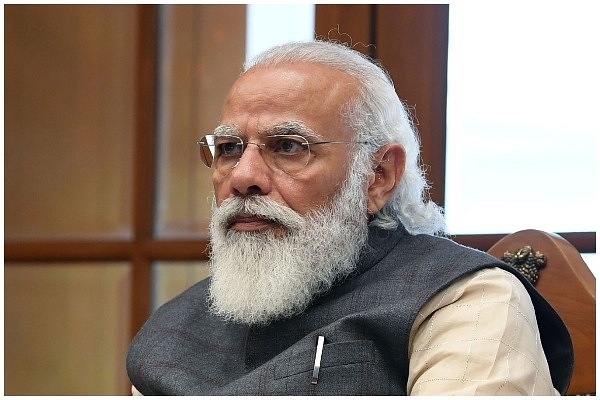Politics
The Great Modi Makeover
- How Narendra Modi is likely to approach politics in his eighth year as the prime minister.

Prime Minister Narendra Modi (PMO)
The eighth year of an Indian prime minister’s tenure has historically been fraught.
Jawaharlal Nehru in 1955 faced a slew of attacks in his eighth year as prime minister: his son-in-law and parliamentarian Feroze Gandhi was a fierce critic in the Lok Sabha of Nehru’s policies. Corruption scandals involving Ramakrishnan Dalmia’s controversial acquisition of The Times of India group raised doubts about public governance in the Nehru administration.
Indira Gandhi in her eighth year as prime minister in 1974 was confronted by Jayaprakash Narayan’s “Total Revolution” movement, rising food prices and widespread public anger against her government. The Emergency would follow a year later.
Manmohan Singh’s eighth year as prime minister in 2012 was his annus horribilis. Anna Hazare’s anti-corruption agitation eroded the UPA2 government’s credibility and led to Singh losing power two years later.
Prime Minister Narendra Modi’s eighth year as prime minister begins in May 2021. It could prove his most challenging yet.
The Modi government has taken a step back on agricultural reforms by agreeing to decriminalise stubble burning and continue subsidising electricity to farmers. It has taken another step back by deferring notification of rules for the Citizenship (Amendment) Act.
One explanation for these retreats is that the government is treading carefully given the high-profile events planned for Republic Day with British Prime Minister Boris Johnson as chief guest if the outbreak following the new Covid mutation allows him to travel.
A more credible explanation is that what we are witnessing in 2021 is the Great Modi Makeover.
The prime minister’s address at the centenary of the Aligarh Muslim University (AMU) launched a kinder, softer version of Modi. By calling Islam an integral part of India’s cultural heritage, Modi went even further than Atal Behari Vajpayee.
According to a translation of Modi’s speech as reported by a leading daily, the prime minister adopted a conciliatory tone on religious identity. He said: “The policies made by the government reach every section irrespective of their religion. Bank accounts of over 40 crore poor have been opened without any discrimination.
“Without discrimination, more than two crore poor were provided pucca houses. More than eight crore women were given gas connections without discrimination. Around 50 crore people got free treatment of up to Rs 5 lakh under the Ayushman scheme without any discrimination. What belongs to the country belongs to every countryman and every citizen should be benefited, our government is working with this spirit.
“AMU’s founder Sir Syed had said that growth of the country is above the caste and religion of the people. He had also given an example and said that for the body to remain healthy, every body part should be healthy. Sir Syed had also said that religion should not be the reason for anyone’s backwardness. India is on the path where no citizen would be left behind because of their religion and everyone would get equal opportunities so that everyone can fulfil their dreams.”
Hardline supporters of Modi fear that Modi’s “soft secularism” is as electorally motivated as Rahul Gandhi’s “soft Hindutva”. They believe both are ideologically corrupt.
Modi’s attempt to woo Muslims, they say, is counter-productive: Muslims see through the hypocrisy of the AMU speech and will anyway vote en masse against the BJP just as Hindus saw through Rahul’s temple-hopping and voted against the Congress.
Modi, most Muslims believe, remains an implacable Hindutva warrior. His actions, they say, belie his words. The Citizenship (Amendment) Act, the revocation of Jammu & Kashmir’s special status and the building of a grand Ram Mandir all point in one direction: hard Hindutva.
But do they really? Modi, like Vajpayee before him, is adept at compartmentalising his persona.
Globally, he exudes the demeanour of a consensual, inclusive statesman. Domestically, he uses a combination of welfare benefit schemes for the poor with hard Hindutva to coalesce the majority vote around the BJP.
Vajpayee himself was a Hindutva hardliner in the early 1990s before softening his tone to appeal to a broader constituency. Hindutva wins elections, especially when overlaid with welfare benefits.
Modi knows that eventually job losses and distress among MSMEs will catch up with him. He has deliberately sought to identify himself with those who have suffered through the Covid pandemic.
The untrimmed beard has symbolic value: it is both a sign of penance and solidarity. Modi is saying, in effect: I am with you in your pain and distress. Gone are the rhetorical flourishes. The body language is less assertive, more empathetic.
Penance and self-denial are time-honoured practices employed by Indian leaders to draw support from the masses. Mahatma Gandhi, with his visible symbols of penance through fasting, self-denial and spartan living and dressing, was an especially successful practitioner of the art.
In the end though, outcomes are what matter. In 2021, Modi’s soft secularism and hard Hindutva will be twin swords that will be sheathed side by side in his electoral scabbard.
Introducing ElectionsHQ + 50 Ground Reports Project
The 2024 elections might seem easy to guess, but there are some important questions that shouldn't be missed.
Do freebies still sway voters? Do people prioritise infrastructure when voting? How will Punjab vote?
The answers to these questions provide great insights into where we, as a country, are headed in the years to come.
Swarajya is starting a project with an aim to do 50 solid ground stories and a smart commentary service on WhatsApp, a one-of-a-kind. We'd love your support during this election season.
Click below to contribute.
Latest